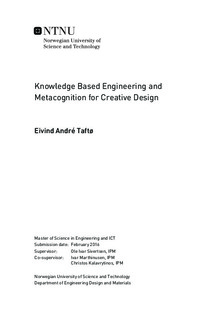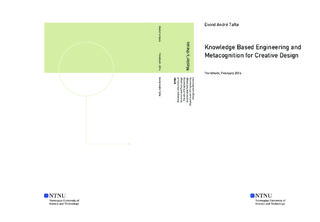| dc.description.abstract | This study focuses on the possibility of using Knowledge Based Engineering (KBE) as a tool for the early creative design phase, using systematic design principles introduced by Eskild Tjalve. In addition, the concept of metacognition was explored to discover how it could relate to KBE and creativity. Specifically, the following research questions guided this research: 1) How can metacognition benefit KBE and creative design? 2) How can KBE technologies support the creative design phase? 3) How can Tjalve s principles be implemented with KBE for a simple product? 4) How can this environment be adapted to work for complex products?
This research study applies design research as a methodological approach. A literature review was conducted on previous research on KBE, creativity, and metacognition. In addition, this study has utilized Eskild Tjalve s work, Systematic Design of Industrial Products. The results of this review provided four learnings which became important for answering the main research questions. Firstly, existing research on KBE technologies indicated how the advantages of these systems could benefit creative design. Secondly, the research on creativity identified potential challenges with emulating human creativity, and revealed different ways of improving human creativity. Third, the study of metacognition delved into the arts of reflective practice and cognitive frameworks for creative design. Existing research suggested that computer systems could possibly embed some of these frameworks. Finally, Tjalve proposed a set of systematic product design principles that seemed feasible to implement using KBE technologies.
These theoretical results provided a knowledge base for the next phase of the study, and the practical part of this research utilizes Tjalve s principles to derive a cognitive framework for systematic design. This framework was then implemented in a pilot KBE environment for doing creative design work on a simple product. The environment was later evaluated to answer the following questions: a) What are the systematic design constraints applied by the chosen framework? b) How do the framework constraints affect creativity? c) How feasible were the framework constraints to implement in KBE?
Based on this evaluation, plans for prototype KBE environments were suggested for future development, where genericity and complex products were considered as advancements. In conjunction with this, HCI design principles were proposed to mitigate associated negative effects on creativity. A framework is proposed that illustrates how metacognition relates to KBE and creativity. In addition, positive and negative constraints for creative design are highlighted. Finally, implications for research and practice, along with limitations and suggestions, are correspondingly discussed in the thesis. | |

